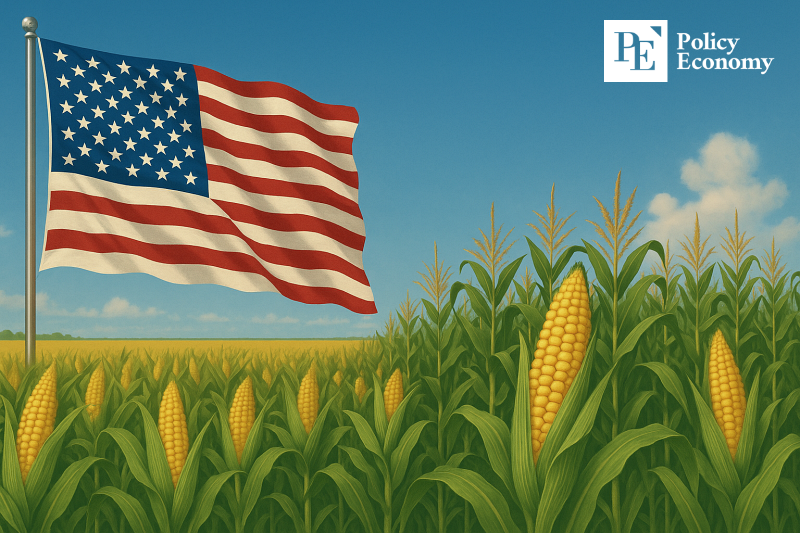U.S. Corn Prices Plunge as Chinese Demand Disappears, Shaking Global Grain Markets
Input
Modified
U.S. Fails to Defend Corn Prices Drop in Chinese Demand Threatens Global Supply Structure Geopolitical Tensions Add to Market Uncertainty

U.S. corn prices have dropped to their lowest level in six months. Since the start of the year, China has completely halted its imports, fracturing the long-standing structure of U.S. grain exports and putting the profitability of Midwest farmers in jeopardy. Adding to the strain are geopolitical tensions and climate-related uncertainties, which are further amplifying price volatility in the global grain market.
Farmers’ Income Hit as Prices Collapse
According to the U.S. Department of Agriculture (USDA) on June 17 (local time), U.S. corn exports from September 2024 to early this month totaled 51.54 million tons, an increase of about 27% year-on-year. South Korea’s imports surged to 4.47 million tons—2.5 times higher than last year. European and African imports also jumped to 3.28 million and 1.59 million tons, respectively, from just a few hundred thousand tons the previous year.
However, China—formerly one of the top four importers of U.S. grain—has virtually stopped buying during this period. The shift stems from escalating U.S.-China trade tensions. During his presidential campaign, Donald Trump pledged to impose a 60% tariff on all Chinese imports. After taking office, he raised tariffs on Chinese goods by up to 145% by April. In retaliation, China imposed additional tariffs of up to 15% on U.S. soybeans, corn, and poultry.
Despite the two countries agreeing last month to a 90-day tariff suspension during high-level talks, China has yet to resume imports of U.S. grain. With the largest buyer absent, corn futures on the Chicago Board of Trade (CBOT) briefly fell to USD 4.20 per bushel on June 10—the lowest in half a year.
China’s strategic reduction in grain purchases is seen as more than a short-term retaliatory measure—it’s reshaping the global grain import structure. China is diversifying its import sources to include Brazil and Russia while also increasing domestic self-sufficiency. If this trend continues, long-term demand for U.S. grain is likely to decline. Given the country’s high export dependency, price volatility will likely intensify.
Midwest farmers—the backbone of U.S. grain production—are already feeling the pressure. The region, traditionally a conservative stronghold and a key political base for President Trump, is expected to suffer income losses due to falling corn prices. This economic strain could shake his political support in the area, according to U.S. political analysts.
Oversupply and Fewer Buyers Increase Stockpile Pressure
The fallout from China’s halt on U.S. grain imports extends beyond the U.S. With the primary buyer out, global supply chains are being flooded with excess inventory, and grain prices are swinging wildly. Major crops like soybeans and wheat are also affected—especially those with high trading volumes and short distribution cycles, which show more dramatic price swings.
There are growing calls for countries like South Korea to diversify suppliers and explore alternative commodities. The Korea Trade-Investment Promotion Agency (KOTRA) noted, “As shipping routes from the U.S. to China decrease, overall freight availability for agricultural products to East Asia will shrink, making it harder for Korea to secure space to import U.S. soybeans.” KOTRA emphasized the need to “closely monitor global production and supply trends given Korea’s heavy reliance on U.S. agricultural imports.”
Last year, the U.S. ranked third among Korea’s corn suppliers, providing 2.5 million tons—22% of total imports. For soybeans, the U.S. exported 580,000 tons to Korea, accounting for half the total. According to Korea’s 2022 food supply data, the country’s soybean self-sufficiency rate was just 7.7%, meaning it relies heavily on imports. As a result, both exporters and importers face urgent pressure to adjust their short-term strategies.

Related Industries Struggle to Shield Prices
Beyond China’s disappearing demand, instability in the grain market is also driven by geopolitical risks. The prolonged war in Ukraine has disrupted exports via the Black Sea, while military conflicts in the Middle East and climate-related yield instability in Europe are collectively putting upward pressure on grain prices. Ukraine and Russia are both major global suppliers of wheat and corn, and export restrictions from the war are a critical factor in supply instability.
This price volatility is affecting not just agriculture but the broader industrial ecosystem, including food manufacturing, livestock, and energy sectors. Grains are key inputs in processed foods, animal feed, and bioethanol production. When prices of corn, soybeans, and wheat rise, the cost of meat, beverages, and even energy increases in tandem. This means grain market turbulence directly leads to consumer price instability.
In light of these developments, market participants are placing more value on stable supply than on price itself. Long-term contracts, more substantial intergovernmental strategic reserves, and alternative raw materials are being pursued to mitigate risks. However, in an era of constant climate and geopolitical crises, no single strategy seems sufficient to ensure market stability. In the future, the grain market is expected to respond more sensitively to long-term unpredictability rather than short-term supply shifts.





















